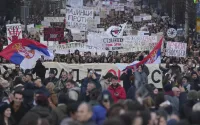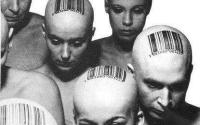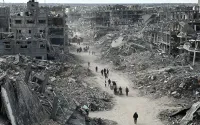26 January 2006
As Hamas wins an upset victory in the Palestinian parliamentary elections, we take a look at the little-known rise of the militant group with investigative journalist Robert Dreyfuss, author of the new book "Devil's Game: How the United States Helped Unleash Fundamentalist Islam." In it, Dreyfuss reveals how the U.S. looked the other way when Israel's secret service supported the creation of Hamas. [includes rush transcript]
According to Middle East analyst Dilip Hero, the success of Hamas in the Palestinian parliamentary elections comes as other Islamist groups gaining political strength in the Middle East. Last year Islamist candidates won most of the seats in the municipal elections in Saudi Arabia. In Lebannon, Hizbollah has emerged as the preeminent representative of Lebanese Shiites. In Egypt, the Muslim Brotherhood won 60% of the seats it contested last year. And in Iraq, religious Shiite and Sunni parties performed best in December parliamentary elections.
To talk about the emergence of Hamas as a political force in the Occupied Territories, we speak with investigative journalist Robert Dreyfuss. He writes about the rise of Hamas in his new book Devil's Game: How the United States Helped Unleash Fundamentalist Islam.
Robert Dreyfuss, investigative reporter and author of the book "Devil's Game: How the United States Helped Unleash Fundamentalist Islam." He is a contributing editor at Mother Jones, the Nation and American Prospect.
More information at RobertDreyfuss.com.
AMY GOODMAN: In light of Hamas's victory in the Palestinian elections, we turn to Robert Dreyfuss right now, investigative reporter and author of the new book, Devil's Game: How the United States Helped Unleash Fundamentalist Islam. We welcome you to our Washington studio at Reuters in D.C., Robert Dreyfuss.ROBERT DREYFUSS: Hi, good morning. Always a pleasure to be here.
AMY GOODMAN: It's good to have you with us. How was Hamas established?
ROBERT DREYFUSS: Well, gosh, you know, you can go back, really 60 or 70 years. The Hamas organization is an outgrowth, really a formal outgrowth, of the Muslim Brotherhood, which was a transnational organization founded in Egypt, which established branches in the '30s and '40s in Jordan and Palestine and Syria and elsewhere. And the Palestinian branch of the Muslim Brotherhood was founded by a man named Said Ramadan, actually the father of Tariq Ramadan, who you mentioned earlier. Said Ramadan was one of the founders of the Brotherhood, who was the son-in-law of its originator, Hassan al-Banna, and he established the Muslim Brotherhood in Jordan and in Jerusalem in 1945. And it grew rapidly during the '40s and was, not surprisingly, a very conservative political Islamic Movement that had a lot of support from the Hashemite royal family of Jordan and from the king of Egypt.
This movement, as it began in the '40s and '50s, ran up against the emerging tide of Arab nationalism, and really the story of Hamas and the story of the Muslim Brotherhood is a continual battle for the last 50 years between Arab nationalists and the Arab left on one hand, and what I would call the Islamic right on the other hand. So the Hamas movement, as it grew out of the Muslim Brotherhood, found itself in the 1960s fighting Arab nationalism in all of these countries, including Egypt.
When Fatah was founded in late 1950s and began taking action against Israel in guerilla warfare in the mid-60s, Hamas was -- or the Muslim Brotherhood was strongly opposed to Fatah. They grew out of the same movement. The Palestinian Fatah organization was founded really out of the League of Palestinian Students, that was a Muslim Brotherhood organization. But the nationalists broke away, and people like Khalil al-Wazir, and Salah Khalaf, and Yasser Arafat and the Hassan brothers, who founded Fatah, broke away from the Muslim Brotherhood in the late 1950s.
And by 1965, the Muslim Brotherhood in Egypt launched its second attempt to kill Nasser at precisely the same time that Nasser was supporting the Palestinian national movement and Fatah against Israel in the areas surrounding the Israeli borders on the Egyptian front. So the Egyptian authorities arrested a man and put him in jail in 1965, named Ahmed Yassin. Ahmed Yassin, of course, is the founder of Hamas. He was, in turn -- we'll get to the end of the story -- was killed by Israel a couple of years ago. But in 1965, he was put in jail by the Egyptian authorities. And then, two years later, of course, when Israel occupied Gaza and the West Bank and, of course, the Sinai peninsula after the 1967 War, the Israelis released Ahmed Yassin and a number of other Muslim Brotherhood leaders.
And starting in 1967, the Israelis began to encourage or allow the Islamists in the Gaza and West Bank areas, among the Palestinian exiled population, to flourish. The statistics are really quite staggering. In Gaza, for instance, between 1967 and 1987, when Hamas was founded, the number of mosques tripled in Gaza from 200 to 600. And a lot of that came with money flowing from outside Gaza, from wealthy conservative Islamists in Saudi Arabia and elsewhere. But, of course, none of this could have happened without the Israelis casting an approving eye upon it.
And during these years, during that 20-year span, the Hamas organization was a bitter opponent of Palestinian nationalism, clashed repeatedly with the P.L.O. and with Fatah, of course, refused to participate in the P.L.O. umbrella. And just as during the '50s and '60s, the Muslim Brotherhood fought against the Nasserists, the Baath Party, the communists and the rest of the Arab left, in the 1970s and '80s, the Muslim Brotherhood fought against the Palestinian national movement. Now that's not even a surprise, you know. In 1970, when the king of Jordan launched his massive counter-offensive against the Palestinians there in that event called Black September, the Muslim Brotherhood was a strong supporter of the king and actually backed his effort, which resulted in thousands of Palestinians killed in a virtual civil war in Jordan.
So there's plenty of evidence that the Israeli intelligence services, especially Shin Bet and the military occupation authorities, encouraged the growth of the Muslim Brotherhood and the founding of Hamas. There are many examples and incidents of that. But there were armed clashes, of course, on Palestinian university campuses in the '70s and '80s, where Hamas would attack P.L.O., PFLP, PDFLP and other groups, with clubs and chains. This was before guns became prominent in the Occupied Territories.
Even that, however -- there's a very interesting and unexplained incident. Yassin was arrested in 1983 by the Israelis. On search of his home, they found a large cache of weapons. This would have been a fairly explosive event, but for unexplained reasons, a year later Yassin was quietly released from prison. He said at the time that the guns were being stockpiled not to fight the Israeli occupation authorities, but to fight other Palestinian factions.
That and other incidents gave rise to -- a number of diplomats and intelligence people who I interviewed, saying that there was plenty of reason to think that the Israelis were fostering the growth of Hamas. And, of course, Yasser Arafat himself, in a famous quote to a newspaper reporter a number of years ago, explicitly described Hamas as, quote, "a creature of Israel." And he said that he discussed this with Yitzhak Rabin during their Oslo process. And Rabin told Arafat that it was "a fatal error" for the Israelis to have encouraged the growth of Hamas. The theory of it, of course, was that Hamas would be a force against Palestinian nationalism. And I think it's clear that it ended up, to a shocking degree, backfiring against overall Israeli policy.
JUAN GONZALEZ: Robert Dreyfuss, the role of the United States in all of this; obviously, the U.S. -- and many people don't recall -- that in the '60s and '70s, was not only worried about the P.L.O. itself, but the other groups you mentioned, the Popular Front and the Democratic Popular Front, which were even more radical and leftist groups than Fatah. The role of the United States while Israel was fostering a development of this movement within the Occupied Territories?
ROBERT DREYFUSS: Well, the United States, of course, has had one constant, that it was a major supporter of Israel and considered Israel an ally, so anything that looked like Palestinian nationalism was seen as a threat to Israel, and the United States, as you might expect, like Israel, refused to even discuss or admit the existence, during those early years, of Palestinians as a force or Palestinian nationalism.
But, of course, the other big ally of the United States in the Middle East was Saudi Arabia, and Saudi Arabia was the main engine and source of support for the Muslim Brotherhood throughout the entire Middle East. So I don't think there's any question that the United States was happy to see the growth of the Islamic Movement in those early years.
The clearest example of this, and I talk about this at length in my book, is when Nasser finally died in 1970 and Anwar Sadat took over as president of Egypt, he had no political base. And so, Sadat encouraged the Muslim Brotherhood to come back to Egypt, and they did, beginning in 1971. Said Ramadan led a Saudi-supported delegation to meet with Sadat. The Brotherhood came back into Egypt and began to organize, with Sadat's official encouragement, and certainly with the knowledge and support of the United States, a powerful political constituency for the Islamists in Egypt. And they not only created mosques, but took over al-Azhar, the main center of the Islamic thought in Cairo and, really, in the world, some people would say, and became a major political and religious presence in Egypt, as well.
Not only that, the United States and Israel, apparently with Jordan's help, too, encouraged the Muslim Brotherhood in Syria in a virtual civil war that began in the 1970s. There were training camps in Jordan and in Lebanon, supported by King Hussein and by the Israelis, with full knowledge of the United States, to train Muslim Brotherhood commandos to try to destabilize the Syrian regime. So the Muslim Brotherhood was a sort of an underground force that was roughly allied, to a significant degree, with America's allies in the Middle East. And the Syrian Civil War, the Lebanese Civil War, the Jordanian Black September Civil War, many of these conflicts that all revolved around control of the Middle East and, in a larger sense, control of the Middle East oil resources, pit the United States against anything that looked like a nationalist force.
AMY GOODMAN: We're talking to Robert Dreyfuss, investigative reporter, author of the new book, Devil's Game: How the United States Helped Unleash Fundamentalist Islam. We've talked about Hamas, which, as you point out, means "zeal"?
ROBERT DREYFUSS: Yes, the words "Islamic Resistance Movement" form the letters that create Hamas, H.M.S., and Hamas, in turn, in Arabic means "zeal."
AMY GOODMAN: Let's turn now to another country very much in the news, and that's Iran. What about the role of the United States in fundamentalist Iran?
ROBERT DREYFUSS: Well, you know, in researching my book, I found myself sitting at lunch one day next to an old gentleman. I asked him -- this was at an old retired C.I.A. officers' conference. And it turned out his name was John Waller. And John Waller, who died last year, was then in his eighties. And I spent several hours interviewing him later on. He was the first C.I.A. station chief in Iran, beginning in 1947, and he served there six years until he returned to Washington in 1953 to coordinate the coup d'etat against Mohammed Mosedeq, an Iranian nationalist, who had just nationalized Iran's oil industry. And, of course, that was the coup that restored the Shah of Iran to his throne after he had fled Iran.
And Waller described to me how the United States reached out to a man named Ahmed Kashani, an ayatollah in Iran and the mentor of Ayatollah Khomeini, in fact. Kashani was then really the king of all Islam in Iran. He worked with an organization, an underground movement called the Devotees of Islam, which was an unofficial branch, again, of the Muslim Brotherhood, even though it was a Shiite organization and the Brotherhood is mostly Sunni. And so, in the 1953 coup d'etat, the United States paid money to Kashani and his religious forces, and they provided the demonstrators, who in turn went out into the streets, saying, "Down with Mosadeq! Bring back the Shah!"
And ironically, one of the great ironies of this story was that Ayatollah Khomeini, himself, who later became the undisputed dictator of Iran in 1979, '81, well, Khomeini himself was in the street with his mentor, Kashani, saying, "Down with Mosedeq! Bring back the Shah!" And so, while the Iranian Shiite religious fundamentalist movement was always suspicious of the Shah and certainly clashed with him repeatedly over the next 25 years, its prime enemy was communism and nationalism. And you even found, after Ayatollah Khomeini came to power in 1979, people like Zbigniew Brzezinski and our ambassador in Iraq now, Zalmay Khalilzad, both argued that Khomeini was a greater threat to the Soviet Union than to the United States and that Islam would destabilize Central Asia, would rouse the Muslims of the Central Asian Muslim republics.
Now, that did not happen. But what did happen was that the United States supported the jihad in Afghanistan, and precisely on that theory that this jihad would not only get the Soviets out of Afghanistan, but would then spread across the border into the Soviet republics. Ironically, I guess, during all of this period, one little-known fact is that the neoconservatives in the 1980s, who were a minority force, not quite the dominant power they are now under the Bush administration, argued vociferously that the United States was wrong in tilting toward Iraq during the Iran-Iraq War. They argued for a tilt in favor of Iran. And that's what led exactly to the Iran-Contra Affair, which had its roots in the neoconservative belief that the United States' true partner in the Gulf was Iran, even though it was led by Khomeini. They felt that there were people there, Rafsanjani and others, that they could deal with.
One of the things I report quite extensively in my book is that throughout the entire Iran-Iraq War, Israel provided significant and steady supply of weapons to Iran. From 1979, and especially after the war with Iraq began, in 1980, the Israelis would meet once a month in Geneva with an Iranian air force team, and the Iranians would give Israel a shopping list. And the Israelis then provided a steady supply of weapons to Iran during its war with Iraq. This is somewhat acknowledged, but basically an unknown footnote to history. Yet it shows, I think, part of the underhanded way in which the Islamists have been seen from time to time as convenient partners, especially during the Cold War, of both the United States, the British and the Israelis, all of whom had their hand in supporting Islamists of one branch or another.
AMY GOODMAN: Robert Dreyfuss, we're going to have to leave it there. We thank you very much for being with us and for writing the book. It's called Devil's Game: How the United States Helped Unleash Fundamentalist Islam.






